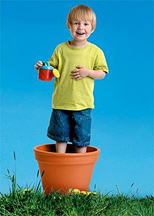Growing Up With Chiropractic
By Dr. Claudia Anrig
Children bump and jar their spines constantly in the first five years of life. After that, even normal, everyday activities can cause spinal trauma with lasting effects. Read these tips on caring for your child's developing spine, starting with their first chiropractic adjustment.
You'll probably never see your 5- or 6-year-old bend over to pick up a toy and freeze in pain, and then hear them say, "Oh, my back went out again." Vertebral subluxations and spinal degeneration that may cause that kind of pain generally will not appear in children - but they can definitely start in childhood.
Birth Trauma and Infant Spinal Stress
For many young parents, natural childbirth may mean that they had a drug-free, vaginal delivery. The question to ask is if the birth was stress-free to you and your baby. Long labor or the use of the suction cap (vacuum extractor), forceps or any forceful long-lever intervention (Caesarean section or extensive pulling on your newborn's neck) may have caused undue stress to their delicate spine. Add to this the improper lifting of the infant out of a car seat or during a diaper change, and the minor spinal traumas that affect the spine and nervous system, which may result in the presence of vertebral subluxation (when the spinal vertebrae lose normal motion or position).
Many parents report that when their infant was given a chiropractic adjustment, their quality of life improved, noting the reduction or complete resolution of common infant health issues such as colic, unexplained crying, poor appetite, reflux, earache, colds and allergic reactions.
Learning to Walk
 When your child takes the first few venturous steps toward walking, they stand next to the table or couch, wobble back and forth a little bit, take one or two hesitant steps toward the middle of the room ... and then plop onto their bottom. In some instances, the child doesn't make it far enough away from the table or chair and hits their head on the furniture. These repeated jars to the spine will not in themselves cause a major spinal injury, but as they accumulate, repetitive stress injuries will occur.
When your child takes the first few venturous steps toward walking, they stand next to the table or couch, wobble back and forth a little bit, take one or two hesitant steps toward the middle of the room ... and then plop onto their bottom. In some instances, the child doesn't make it far enough away from the table or chair and hits their head on the furniture. These repeated jars to the spine will not in themselves cause a major spinal injury, but as they accumulate, repetitive stress injuries will occur.
Exploring Their Surroundings
During the first few years of life, children will develop from helpless infants into fearless adventurers. Bumps and falls naturally come with your child's desire to learn everything about the world around them in the quickest amount of time possible, but these bumps and falls will cause strain and trauma to the spine. When spinal bones lose their normal position or ability to move during this stage of tremendous physical growth, possible permanent deformities (spinal asymmetry) can occur. Left uncorrected, these small cumulative traumas potentially can have far-reaching effects.

